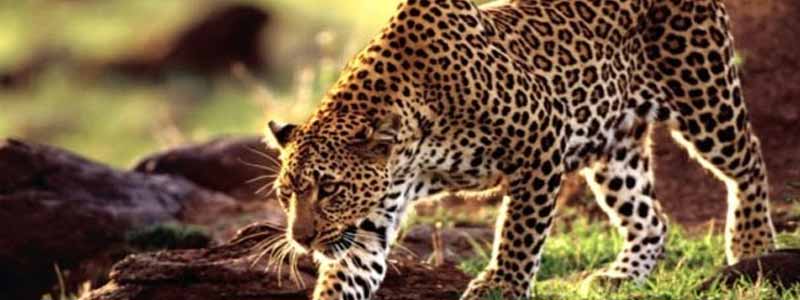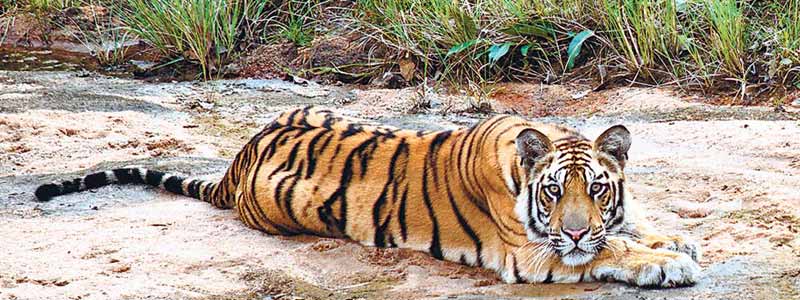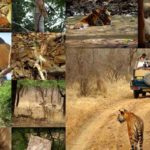Darrah National Park a national park with hilly terrain and thick forest spread over 250sq km in area, was declared a wild life reserve in the year 1955. It was the favourite hunting grounds of the royal rulers of Kota until it was declared a reserve sanctuary. It is located about 48 kms from the city of Kota.
The name Darrah is interpreted as the ‘pass’ in the local language revealing the purpose that the region served earlier. The Marathas, Rajputs and the British utilized the opportune position of the forest to seek asylum during the war. Darrah Wildlife Sanctuary is home to leopards, sloth bears, antelopes, nilgai, deers and wolves. Antelopes and wolves are seen in particularly large numbers and if you are lucky enough you can also spot few leopards and sloth bears that inhabit the sanctuary.
It is really a delight to see these wild animals in their natural habitat. The River Chandrabhaga streams near the sanctuary. The visit to the Darrah Wildlife Sanctuary will present to its visitors a glance of the spotted deer that reside in the region. The Jhalwar Fort that lies in close proximity from the Darrah Sanctuary is a marvelous structure. The Jenana Khas located within the precincts of the fort is even more admirable.
Best time to visit is from October to March as it is closed from July to September. Visitors can go for a Wildlife Safari in the jeeps provided by the forest department or can go for an adventurous trek through the lush green foliage. It is sanctuary is open to visitors during timings 10 AM to 5 PM regularly. The national tourists require a visiting ticket of Rs. 20 while international tourists require a ticket of Rs 100 per person to enter the premises of the sanctuary.

History of Darrah National Park
In earlier times, the Darrah National Park used to be a royal hunting game reserve for the Maharaja of Kota because of the abundance of astonishing wildlife creatures. The name Darrah means ‘pass’ in the local language implying towards the purpose this region served during that time. The Rajputs, the Marathas and the British exploited the privileged position of these forest grounds to seek asylum during wars. In 1955, the Government of India declared this region as a protected area and the Darrah National Park came into existence in 2004.

Famous places to visit in Darrah National Park
There are a few places that can be visited on the trip to the Park. The places are:
Jhalawar Fort
Jhalawar Fort, locally named Garh Palace, is situated in the heart of the city and is a popular Rajasthan tourist attraction. Founded by Maharaj Rana Madan Singh and his followers during the years 1840-1845, this palace is mainly known for its magnificent works, which can only be seen after the authorities have granted it their special permission. At a brief stop in the fort, Jhalawar visitors should stop at the magnificent Zenana Khas or “Women’s Palace,” where walls and elaborate frescoes decorated in an extravagant mirage can never fail to impress anyone.
Jhalrapatan
Jhalrapatan is a city in southern India’s Jhalawar district. It has around 37,506 inhabitants. In Jhalrapatan the first municipality was created. It was founded as India’s last fort and is a great historic place to visit.
Jenna Khas
This is inside the fort and Jhairapatan was founded in the 10th century and famous for the ruins of the Sun Temple. A host of ancient temples are situated on the banks of the river Chandrabhaga, most of them built between the 7th and the 8th centuries. Visiting the haunting sanctuary of Darrah is a very enjoyable experience because it offers not only its wild side but also its rich past. One must not forget that from July to September the sanctuary is not limited to tourists.
River Chandrabhaga
Ruins of ancient temples were constructed on the banks of the river during the 7th and 8th centuries. The river banks are known and active as the Chandrabhaga Fair, which is dedicated to the river, takes place during the Kartik Purnima month of October / November. On this day, thousands of fans are dipping in this river. This fair draws tourists so they can become acquainted with traditions and customs. During the fair, there are many contests involving animals and mustache, and tourists are attracted to this fair.

Best time to visit Darrah National Park
The best time to visit the National Park is from February to May. This national park is located at a distance of 50 km from Kota and is considered one of Rajasthan’s most renowned national parks. This was historically to be the place of royal hunting, and the Rajputs, Marathas, and Britons used the land during wars to seek asylum. In around 1955, this park was declared a protected area by the government of India, and this national park was launched in 2004. This place is a famous tourist visiting a place with astonishing sightseeing.
How To Reach Darrah National Park
Darrah National Park is 50 kilometres away from Kota. The bus station at Kota is well connected to the major cities of Rajasthan like Jaipur, Ajmer, Chittorgarh and Udaipur. It takes roughly around 6 hours to reach Kota from these cities.
By air: Mukundra (Darrah) national park is about 300 km from Kota and the nearest airport is Udaipur.
By Rail: Kota is situated at about 50 km from Mukundra Hills (Darrah) National Park. By Rail The nearest railway station is Kota.
By Bus: The bus stop in Kota on the road to Bundi on the eastern bank of the Chambal River is the closest bus station to Darrah. This resort offers great facilities in all major Rajasthan cities such as Ajmer, Chittorgarh, Jaipur, Udaipur, and so on.








